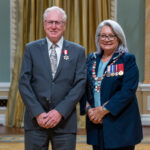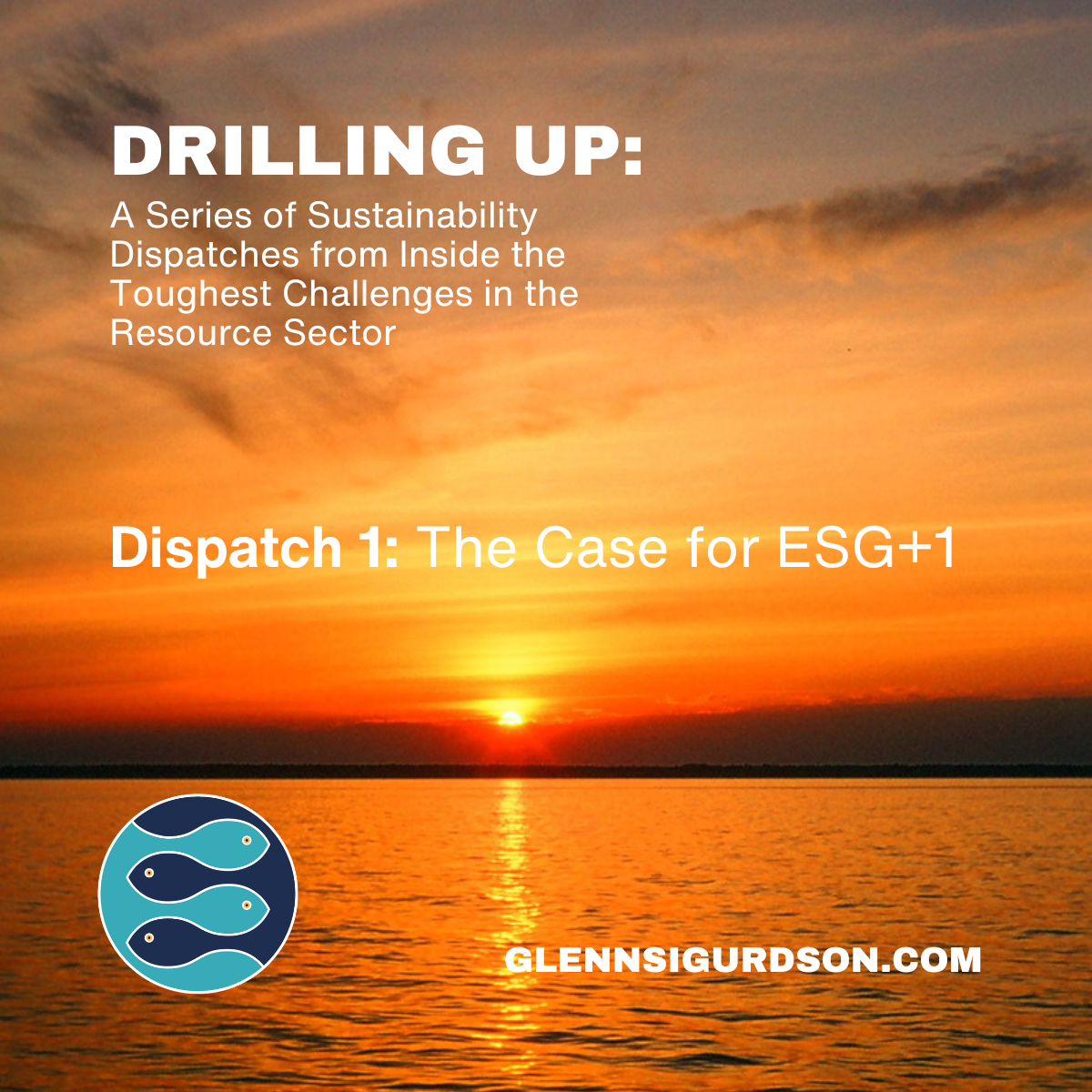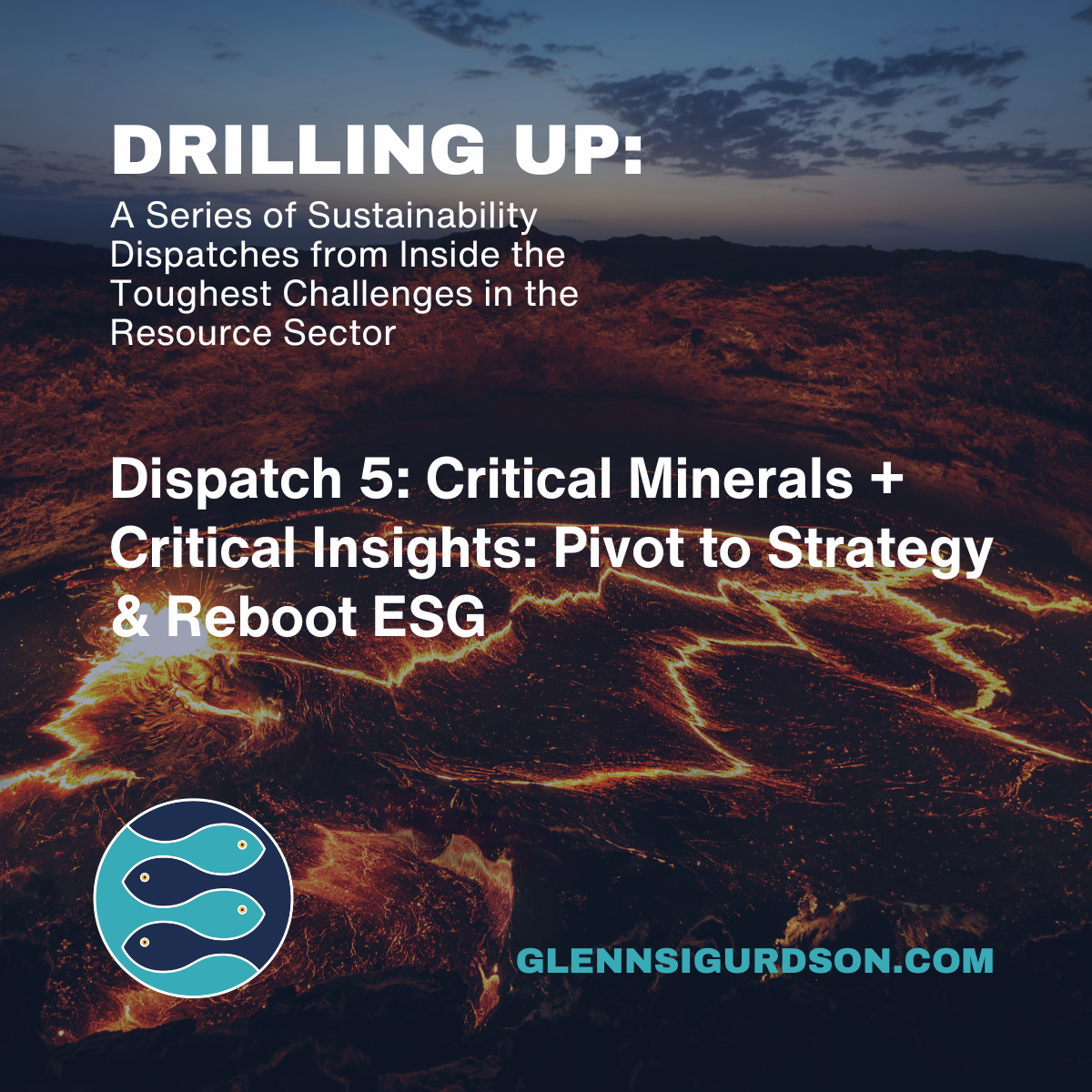
Order of Canada recipient 2022 – Stefan Glenn Sigurdson, C.M., K.C.
November 1, 2022
Dispatch 2: The Trojan Horse inside ESG: The Cracks Hidden Within the Organization
November 15, 2024“It’s time to put the I into ESG!” This was the call to action from Indigenous Tahltan Elder Allen Edzerza, a prominent leader, colleague, and friend, at a recent Wall Street Green Summit.
When it comes to business operations and investment decisions today, financial metrics are no longer regarded as sufficient to identify material risks and opportunities. ESG — Environment, Social, and Governance – has come into favour as an acronym reflecting the broad categories within which standards are being developed for measuring sustainability performance and reporting accordingly to investors, markets, and the public. “Sustainable investments” as a distinct class of assets have been surging in the past five years and show no signs of slowing. What Allen and others are suggesting is that I –– for Indigenous –– should be added as a distinct category.
Some may cynically allege this is just another example of political correctness overreach. Others may say that adding to the acronym will simply generate confusion. Still others may assert that “Indigenous” is already implicit in the broad ESG factors. However, I believe there are compelling reasons for the addition, as it will recognize a reality, reduce confusion, and add clarity.
The Indigenous Reality around the Globe
The Indigenous footprint is found almost everywhere across the globe. The United Nations estimates there to be over 370 million people in 70 countries, belonging to more than 5,000 groups, and speaking over 400 languages, with such a deep and timeless connection to a region or watershed that they and the lands on which they have lived over countless generations are at one. While they comprise only 5% of the world’s population, they are present on approximately 22% of the land, on which remains an estimated 80% of the planet’s biodiversity.
People indigenous to a place know their surroundings by watching, listening, and learning about the plants and animals on the land, the birds in the air, and the fish in the sea. Living so directly in the natural world, they understand it viscerally and know that everything is interconnected.
Here on the West Coast of Canada, when the salmon spawn, they give nourishment to the bears before winter hibernation and to the eagles preparing for another winter. When the migrating flocks fail to appear one year, the people worry about what this bodes for the next year. Their ancestors watched the rhythms of the natural world, built cultures around it, and passed their knowledge onward through the generations.
With the world’s population continuing to grow, the hunt for resources is unrelenting, the demand insatiable. When it comes to mineral, oil, and gas exploration and development, there are few places on the planet where these activities do not impact the lives, livings, and lifestyles of Indigenous people. They are the eyes and ears on the ground, constantly attuned to threats to the land and waters where they live and the biodiversity these sustain. Increasingly, early warning signals are voiced by Indigenous people claiming and asserting their natural right to serve as the earth’s guardians. Not including Indigenous people in conversations involving a plan, a decision, or an activity impacting Indigenous lands is a risky course of action. The public conscience on these matters has been awakened. There is now a long track record of intense conflicts erupting, major projects stopped in their tracks, advocacy campaigns, public outcries, and searing media stories.
Indigenous Rights on the March
After centuries in darkness, Indigenous rights have entered the global stage. A growing body of national and international law has been emerging over the past fifty years, recognizing and respecting Indigenous rights in relation their lands and their distinctive and diverse cultures, languages, and histories. In 2007, these changes culminated in the United Nations Declaration on the Rights of Indigenous Peoples, which has been adopted by 148 countries around the world. Prominent within the Declaration is Indigenous people’s right to give or withhold free, prior, and informed consent (FPIC) for proposed development on or near traditional lands.
Tensions between Indigenous rights and resource development are longstanding, and intense conflicts have arisen even in some of the most hidden and remote corners of the globe. FPIC has been an inflection point in the rights trajectory, changing power dynamics and giving rise to a new reckoning. Each collision has been gradually shaping a new reality in which both sides come to grips with the fact that they must find ways to live with each other in spite of their differences. And in some quarters, alongside that awareness is a growing appreciation of the opportunities that could be created if protagonists could be turned into partners.
In the wake of rights have come appeals for reconciliation. Many countries have now acknowledged a long history of injustices to Indigenous people, typically tracing to colonial pasts. In Canada and some other countries, this has led to specific recommendations for reconciliatory actions in every sector of society, including the corporate world.
Slowly but surely, the social pendulum is swinging from rights, to reconciliation, to respect. The call for ESG + I is a request for respect.
The Indigenous World View
Gro Harlem Brundtland, Norway’s first female prime minister, introduced sustainable development to the world in the 1987 Brundtland Report with these simple but powerful words: “development that meets the needs of the present without compromising the ability of future generations to meet their needs.” In the preface to the report, she noted that “when the terms of reference of our Commission were originally being discussed in 1982, there were those who wanted its considerations to be limited to ‘environmental issues’ only. This would have been a grave mistake. The environment does not exist as a sphere separate from human actions, ambitions, and needs, and attempts to defend it in isolation from human concerns have given the very word ‘environment’ a connotation of naivety in some political circles.” She understood that the heartbeat of sustainability is human behaviour.
In this definition, the essence of sustainability is intergenerational equity, grounded in matters of morality and distributive justice. The definition challenged the world to embrace a new way of thinking, being, and acting and find resolutions for conflicts in values, interest, and power. It recognized the need to reach consensus on what a sustainable future might look like and to develop new ways to resolve differences, reach decisions, and build resilient relationships. It spoke to questions of conduct and culture. In the three-plus decades since the “sustainability” concept’s introduction, we have struggled to define it with sufficient specificity to prescribe responsibilities and accountabilities and to measure and report on actions for achieving it. In our preoccupation with toolkits and scorecards, have we left the essence of sustainability as Brundtland described it to languish in the shadows?
Indigenous cultures and history have much to teach us about this essence. Indigenous values draw their life force from Mother Earth. This ancient spirituality understands the mystery and majesty of the world around us, both animate and inanimate. The Indigenous world view puts the human condition within nature, not apart. It understands all living things to be in a state of Interdependence with one another. The cultures shaped around these moral values were based on responsibility and accountability, on following the principle of taking only what is needed so as to protect Mother Earth for future inhabitants. Later generations who are not as closely connected to the land embody these values in their own ways as part of their Indigenous identities.
When we turn to the corporate world, we find complicated organizations with multiple business units and operations. In the absence of a sustainability culture that guides, disciplines, and incentivizes a way of thinking and acting, up and down and across, delivering sustainability outcomes consistently and resiliently is always at risk of short-circuiting, regardless of what “ESG Statement” is posted on a company website. Culture drives organizational alignment and integration. Corporate culture is not easy to measure, but you can grasp it by asking a simple question: “Who owns sustainability?”, the same question that is often asked of safety within an organization. If the answer is not “everyone,” then there is work to do, no matter what ESG facts and figures are presented.
Indigenous wisdom has much to teach us about building a sustainable future. It has been resilient across generations because it reflects a way of being, a way of thinking about our place and relationships within the natural world. Sustainability is not about reaching some “been there, done that” place. It cannot be captured within lines and boxes, metrics and report cards — which are, to be sure, helpful as guideposts but should never be stopping places. Adding the “I” will provide a talisman for this all-important journey.
Drilling Up: A Series of Sustainability Dispatches from Inside the Toughest Challenges in the Resource Sector
This is the first in a series of “dispatches” whose goal will be to provide practical guidance on what it takes to deliver sustainable performance. Extrapolating from broad themes, I will “drill up” from five decades of experience in working as the “man in the middle” of complex challenges involving people and resources, helping to resolve differences and build partnerships. My experience has taken me inside organizations as well as between and among them in diverse sectors: fish and forests, land and water, mines and dams, gas-processing plants and nuclear waste, pipelines and transmission lines, energy, municipal transportation conflicts, and treaty negotiations. In these arenas, values, rights, interests, and power collide, engaging different organizational and governing structures and cultures, distinct “publics,” and the public interest.
Glenn Sigurdson, C.M.
Social innovator, Organizational consultant, teacher, writer, speaker
glennsigurdson.com; gemm.ca; prairieocean.ca
Footnote 1
Pimachiowin Aki (‘The Land That Gives Life’) a UNESCO World Heritage Site on the east shore of Lake Winnipeg is landscape of rivers, lakes, wetlands, and boreal forest. It forms part of the ancestral home of the Anishinaabeg, an indigenous people living from fishing, hunting and gathering. The site encompasses the traditional lands of four Anishinaabeg communities (Bloodvein River, Little Grand Rapids, Pauingassi and Poplar River). It is an exceptional example of the cultural tradition of Ji-ganawendamang Gidakiiminaan (‘keeping the land’), which consists of honouring the gifts of the Creator, respecting all forms of life, and maintaining harmonious relations with others. A complex network of livelihood sites, habitation sites, travel routes and ceremonial sites, often linked by waterways, provides testimony to this ancient and continuing tradition.



